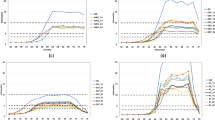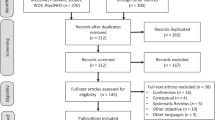Abstract
This manuscript suggests a new method of instrument selection in novel applications. Dimension change profile analysis was developed to ensure the credibility and validity of the observed outcomes while maximizing the probability of obtaining statistically significant results.
Ad-hoc or disease-specific instruments developed for a specific purpose, which are generally more responsive to changes in patient health status, may suffer from lack of acceptance by regulatory agencies. Dimension change profile analysis addresses this issue by providing a systematic, defensible method for selecting a previously developed, complementary instrument to provide additional validation of results.
Meta-analytical techniques are used to derive from the literature a profile of impairments in dimensions of health-related quality of life associated with the underlying disease state, and to produce a profile of likely change or effect for the intended interventions. When the two profiles are combined it produces a profile of the dimensions in which significant change is possible.
Possible change is then compared to the relevant group of available, previously validated off-the-shelf instruments. The process facilitates and systematizes the selection of a “companion” instrument in such a manner that the probability of finding significant results with the secondary instrument is optimized, while permitting the researcher to benefit from the use of an instrument whose previous use and acceptance enhances credibility and validity. A hypothetical example is presented to illustrate the technique.
Similar content being viewed by others
References
Jack W. Pharmaceutical differentiation through quality of life measurement: Case study. J Pharma Mark Manag. 1991;6(1):65–85.
Murawski MM, Miederhoff PA. On the generalizability of statistical expressions of health related quality of life instrument responsiveness: a data synthesis. Qual Life Res. 1998;7:11–22.
Guyatt GH, Feeny DH, Patrick DL, Veldhuyzen Van Zanten SJ. Measuring quality of life in clinical trials: a taxonomy and review. Can Med Assos J. 1989;140:1441–1448.
Freeman RA. Standards for the conduct of industry-sponsored economic and quality of life research. J Res Pharm Econ. 1992;4,2, 15–30.
Morris LA, Blake LA. Outcomes research: FDA perspective. J Res Pharm Econ. 1997;8(1): 209– 213.
Smith ND. Quality of life studies from the perspective of an FDA reviewing statistician. Drug Inf J. 1993;27(3)617–623.
Chassany O, Sagnier P, Marquis P, Fullerton S, Aaronson N. Patient-reported outcomes: The example of health related quality of life—a European guidance document for the improved integration of health-related quality of life assessment in the drug regulatory process. Drug Inf J. 2002;36(1):209–238.
Revicki DA, Osoba D, Fairclough D, Barofsky I, Berzon R, Leidy NK, Rothman M. Recommendations on health-related quality of life research to support labeling and promotional claims in the United States. Quality Life Res. 2000;9(8): 887–900.
Cooper H, Hedges LV, eds. The Handbook of Research Synthesis. New York, NY: Russell Sage Foundation; 1994.
Lipsey MW, Wilson DB. Practical Meta-Analysis. Thousand Oaks, CA: Sage Publications, 2001.
Daly E, Gray A, Barlow D, McPherson K, Roche M, Vessey M. Measuring the impact of menopausal symptoms on quality of life. Br Med J. 1993; 307:836–840.
Coope J, Hunter M. Impact of menopausal symptoms. Effect on quality of life exaggerated. Br Med J. 1993;307:1420.
Alder EM, Ross L. Impact of menopausal symptoms. Study perpetuates false impression. Br Med J. 1993;307:1420–1421.
Cohen J. Statistical Power Analysis for the Behavioral Sciences. Hillsdale, NJ: Lawrence Erlbaum Assoc.; 1988.
Bouchet C, Guillemin F, Briancon S. Nonspecific effects in longitudinal studies: impact on quality of life measures. J Clin Epidemiol. 1996;49(1): 15–20.
Maheux R, Naud F, Rioux M, Grenier R, Lemay A, Guy J. Langevin M. A randomized, double-blind, placebo-controlled study on the effect of conjugated estrogens on skin thickness. Am J Obstet Gynecol. 1994; 70:642–649.
Wiklund I, Karlberg J. Mattsson L. Quality of life of postmenopausal women on a regimen of transdermal estradiol therapy: a double blind placebo-controlled study. Am J Obstet Gynecol. 1993; 168:824–830.
Derman RJ, Dawood MY, Stone S. Quality of life during sequential hormone replacement therapy—a placebo-controlled study. Int J Fertil Menopausal Stud. 1995;40(2):73–78.
Karlberg J. Mattsson LA, Wiklund I. A quality of life perspective on who benefits from estradiol replacement therapy. Acta Obstet Gynecol Scand. 1995;74(5):367–372.
Nathorst Boos J, Wiklund I, Mattsson LA, Sandin K, von Schoultz B. Is sexual life influenced by transdermal estrogen therapy? A double blind placebo controlled study in postmenopausal women. Acta Obstet Gynecol Scand. 1993;72: 656–660.
Wiklund I, Holst J. Karlberg J, Mattsson LA, Samsioe G, Sandin K, Uvebrant M, von Schoultz B. A new methodological approach to the evaluation of quality of life in postmenopausal women. Maturitas. 1992;14:211–224.
Wiklund I., Berg G, Hammar M, Karlberg J, Lindgren R, Sandin K. Long-term effect of transdermal hormonal therapy on aspects of quality of life in postmenopausal women. Maturitas. 1992;14: 225–236.
Hunter JE, Schmidt F. Methods of Meta-Analysis. Newbury Park, CA: Sage Publications, Inc.; 1990:23–42.
Rosenthal R. Meta-Analytic Procedures for Social Research. Newbury Park, CA: Sage Publications, Inc.; 1991:3–35.
Author information
Authors and Affiliations
Rights and permissions
About this article
Cite this article
Murawski, M.M. Dimension Change Profile Analysis: A Systematic Approach to Health-Related Quality of Life Instrument Selection in Novel Applications. Ther Innov Regul Sci 37, 165–175 (2003). https://doi.org/10.1177/009286150303700206
Published:
Issue Date:
DOI: https://doi.org/10.1177/009286150303700206




